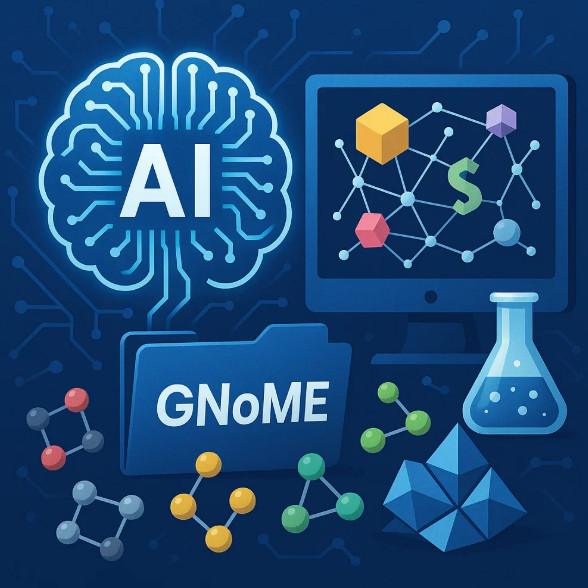AIк°Җ м—¬лҠ” мӢ мҶҢмһ¬мқҳ лҜёлһҳ, GNoME н”„лЎңм қнҠё
мқёлҘҳлҠ” мғҲлЎңмҡҙ л¬јм§Ҳмқ„ м°ҫм•„лӮҙлҠ” кіјм •м—җм„ң лҠҳ н•ңкі„лҘј л§ҲмЈјн•ҙмҷ”лӢӨ. к·ёлҹ¬лӮҳ мқёкіөм§ҖлҠҘмқҙ к·ё л¬ҙн•ңн•ң к°ҖлҠҘм„ұмқҳ мҲІмқ„ 비추лҠ” л“ұл¶Ҳмқҙ лҗҳкі мһҲлӢӨ. GNoME н”„лЎңм қнҠёлҠ” вҖҳмһ¬лЈҢ л°ңкІ¬мқҳ лҜёлһҳвҖҷк°Җ мқҙлҜё мӢңмһ‘лҗҳм—ҲмқҢмқ„ ліҙм—¬мӨҖлӢӨ.
мқёк°„мқҳ м§ҒкҙҖмқ„ л„ҳм–ҙм„ мһ¬лЈҢ нғҗмғү
мҡ°лҰ¬к°Җ л§Өмқј мӮ¬мҡ©н•ҳлҠ” мҠӨл§ҲнҠёнҸ°, м „кё°м°Ё, нғңм–‘кҙ‘ нҢЁл„җмқҖ лӘЁл‘җ вҖҳмһ¬лЈҢ кіјн•ҷвҖҷмқҳ м„ұкіјл¬јмқҙлӢӨ. л°ҳлҸ„мІҙ 칩м—җ м“°мқҙлҠ” мӢӨлҰ¬мҪҳ, л°°н„°лҰ¬ мҶҚ лҰ¬нҠ¬, мқҳн•ҷм—җм„ң мӮ¬мҡ©н•ҳлҠ” мғқмІҙ м Ғн•©м„ұ кёҲмҶҚ л“ұ мқҙл“Ө л¬јм§ҲмқҖ м–ҙлҠҗ лӮ к°‘мһҗкё° н•ҳлҠҳм—җм„ң л–Ём–ҙ진 кІғмқҙ м•„лӢҲлӢӨ. кіјн•ҷмһҗл“Өмқҙ мҲҳмӢӯ л…„м—җ кұёміҗ мғҲлЎңмҡҙ л¬јм§Ҳмқ„ л°ңкІ¬н•ҳкі , н•©м„ұн•ҳл©°, м„ұлҠҘмқ„ нҷ•мқён•ҳлҠ” кіјм •мқ„ кұ°міҗ м„ёмғҒм—җ лӮҳмҳЁ кІ°кіјлӢӨ.
н•ҳм§Җл§Ң м—¬кё°м—җлҠ” м»ӨлӢӨлһҖ н•ңкі„к°Җ мһҲм—ҲлӢӨ. мқёлҘҳк°Җ мӮ¬мҡ©н• мҲҳ мһҲлҠ” нҷ”н•ҷм Ғ мЎ°н•©мқҖ мӮ¬мӢӨмғҒ л¬ҙн•ңлҢҖм—җ к°Җк№қлӢӨ. лӘЁл“ мӣҗмҶҢлҘј мЎ°н•©н•ҙ мғҲлЎңмҡҙ кІ°м • кө¬мЎ°лҘј л§Ңл“Өм–ҙлӮҙлҠ” кІҪмҡ°мқҳ мҲҳлҠ” мғҒмғҒмқ„ мҙҲмӣ”н•ңлӢӨ. к·ё мҶҚм—җм„ң вҖҳм“ёлӘЁ мһҲлҠ” мӢ мҶҢмһ¬вҖҷлҘј м°ҫлҠ” мқјмқҖ л§Ҳм№ҳ л°”лҠҳкө¬л©Қмқ„ нҶөн•ҙ мҡ°мЈјлҘј л“Өм—¬лӢӨліҙлҠ” кІғкіј к°ҷлӢӨ. кіјн•ҷмһҗл“ӨмқҖ кі„мӮ°кіј м§ҒкҙҖм—җ мқҳмЎҙн•ҙ мЎ°кёҲм”© нӣ„ліҙлҘј мўҒнҳҖмҷ”м§Җл§Ң, м—¬м „нһҲ л§ҺмқҖ к°ҖлҠҘм„ұмқҙ лҜём§Җмқҳ мҳҒм—ӯмңјлЎң лӮЁм•„ мһҲлӢӨ.
мқҙ м§Җм җм—җм„ң мқёкіөм§ҖлҠҘмқҙ л“ұмһҘн–ҲлӢӨ. кө¬кёҖ л”Ҙл§Ҳмқёл“ң(DeepMind)к°Җ л°ңн‘ңн•ң 'GNoME(Generalist Neural Network for Materials Exploration)' н”„лЎңм қнҠёлҠ”, мқёк°„мқҳ м§ҒкҙҖл§ҢмңјлЎңлҠ” лӢҝкё° м–ҙл Өмҡҙ мҳҒм—ӯмқ„ лҢҖмӢ нғҗн—ҳн•ҳлҠ” мғҲлЎңмҡҙ кёёмһЎмқҙлӢӨ. мқёкіөм§ҖлҠҘмқҙ мҠӨмҠӨлЎң мҲҳл°ұл§Ң к°ңмқҳ мғҲлЎңмҡҙ кІ°м • кө¬мЎ°лҘј м°ҫм•„лӮҙкі , к·ёмӨ‘ м•Ҳм •м ҒмңјлЎң мЎҙмһ¬н• к°ҖлҠҘм„ұмқҙ нҒ° кІғл“Өмқ„ 추л ӨлӮё кІғмқҙлӢӨ.
GNoMEмқҳ нҳҒмӢ м Ғ м ‘к·ј
кё°мЎҙмқҳ мӢ мҶҢмһ¬ м—°кө¬лҠ” вҖҳкі„мӮ° нҷ”н•ҷвҖҷм—җ нҒ¬кІҢ мқҳмЎҙн–ҲлӢӨ. мҠҲнҚјм»ҙн“Ён„°лҘј нҷңмҡ©н•ҙ мӣҗмһҗ к°„ мғҒнҳёмһ‘мҡ©мқ„ кі„мӮ°н•ҳкі , л¬јм§Ҳмқҙ м•Ҳм •м ҒмңјлЎң мЎҙмһ¬н• мҲҳ мһҲлҠ”м§ҖлҘј нҷ•мқён•ңлӢӨ. н•ҳм§Җл§Ң мӣҗмһҗк°Җ мҲҳл°ұ к°ңл§Ң лҸјлҸ„ кі„мӮ°лҹүмқҖ кё°н•ҳкёүмҲҳм ҒмңјлЎң лҠҳм–ҙлӮңлӢӨ. мҲҳмӢӯ л…„ лҸҷм•Ҳ мқҙлЎ м—°кө¬мҷҖ мӢӨн—ҳмқҙ лӮҳлһҖнһҲ лӢ¬л Өмҷ”м§Җл§Ң, вҖңк°ҖлҠҘм„ұмқҳ мҡ°мЈјвҖқлҘј лӢӨ л’Өм§Җкё°м—җлҠ” н„ұм—Ҷмқҙ л¶ҖмЎұн–ҲлӢӨ.
GNoMEмқҖ мқҙлҹ° л¬ём ңлҘј к·јліём ҒмңјлЎң мһ¬м„Өкі„н•ңлӢӨ. мҲҳл§ҺмқҖ кё°мЎҙ кІ°м • кө¬мЎ° лҚ°мқҙн„°лҘј н•ҷмҠөн•ң л”Ҙлҹ¬лӢқ лӘЁлҚёмқ„ мқҙмҡ©н•ҙ, мғҲлЎңмҡҙ мЎ°н•©мқҙ м–јл§ҲлӮҳ м•Ҳм •м ҒмңјлЎң мЎҙмһ¬н• мҲҳ мһҲмқ„м§ҖлҘј 'мҲңмӢқк°„м—җ мҳҲмёЎ'н•ңлӢӨ. лӢӨмӢң л§җн•ҙ, мқјмқјмқҙ л¬јлҰ¬н•ҷ л°©м •мӢқмқ„ н’Җм§Җ м•Ҡкі лҸ„ вҖңмқҙ л¬јм§ҲмқҖ мӮҙм•„лӮЁмқ„ мҲҳ мһҲлӢӨвҖқлқјлҠ” к°ҖлҠҘм„ұмқ„ м җмҲҳнҷ”н•ҙмЈјлҠ” кІғмқҙлӢӨ.
нқҘлҜёлЎңмҡҙ м җмқҖ мқҙ лӘЁлҚёмқҙ лӢЁмҲңнһҲ вҖҳмһҲлӢӨ/м—ҶлӢӨвҖҷлҘј л§җн•ҳлҠ” кІғмқҙ м•„лӢҲлқј, 'нҷ•лҘ м Ғ м•Ҳм •м„ұ м§ҖлҸ„'лҘј к·ёл ӨмӨҖлӢӨлҠ” м җмқҙлӢӨ. лҚ•л¶„м—җ м—°кө¬мһҗл“ӨмқҖ л¬ҙн•ңн•ң нӣ„ліҙкө° мӨ‘м—җм„ңлҸ„ мң л§қн•ң мҳҒм—ӯмқ„ мҡ°м„ м ҒмңјлЎң мӮҙнҺҙліј мҲҳ мһҲлӢӨ. л§Ҳм№ҳ м–ҙл‘ мҶҚм—җм„ң л¬ҙмһ‘м • н—Өл§ӨлҚҳ нғҗн—ҳк°Җм—җкІҢ мҶҗм „л“ұмқҙ мғқкёҙ м…ҲмқҙлӢӨ.
м—°кө¬ м„ұкіј: мҲҳл°ұл§Ң к°ңмқҳ мғҲлЎңмҡҙ нӣ„ліҙ
мқҙлІҲ м—°кө¬м—җм„ң GNoMEмқҖ '220л§Ң к°ңк°Җ л„ҳлҠ” м•Ҳм •м Ғ кІ°м • кө¬мЎ° нӣ„ліҙ'лҘј м ңмӢңн–ҲлӢӨ. мқҙлҠ” м§ҖкёҲк№Ңм§Җ кіјн•ҷмһҗл“Өмқҙ лҚ°мқҙн„°лІ мқҙмҠӨлЎң кҙҖлҰ¬н•ҳлҚҳ м•Ҳм •м Ғ нҷ”н•©л¬ј мҲҳлҘј лӘҮ л°°лӮҳ лӣ°м–ҙл„ҳлҠ” к·ңлӘЁлӢӨ. к·ёмӨ‘ мғҒлӢ№мҲҳлҠ” мқёлҘҳк°Җ м•„м§Ғ н•ң лІҲлҸ„ кё°лЎқн•ҳм§Җ лӘ»н–ҲлҚҳ мҷ„м „нһҲ мғҲлЎңмҡҙ л¬јм§ҲмқҙлӢӨ.
лҚ” лҶҖлқјмҡҙ мӮ¬мӢӨмқҖ мқҙ мҳҲмёЎ мӨ‘ мқјл¶Җк°Җ мқҙлҜё мӢӨн—ҳмӢӨм—җм„ң н•©м„ұ к°ҖлҠҘм„ұмқҙ нҷ•мқёлҗҳм—ҲлӢӨлҠ” м җмқҙлӢӨ. лӢЁмҲңнһҲ вҖҳмқҙлЎ мҶҚмқҳ л°ңкІ¬вҖҷм—җ лЁёл¬ҙлҘҙм§Җ м•Ҡкі , мӢӨм ңлЎң мҶҗм—җ мһЎнһҲлҠ” л¬јм§ҲлЎң мқҙм–ҙм§Ҳ мҲҳ мһҲмқҢмқ„ ліҙм—¬мӨҖ кІғмқҙлӢӨ. кіјкұ°м—җлҠ” кі„мӮ°кіј мӢӨн—ҳ мӮ¬мқҙмқҳ к°„к·№мқ„ л©”мҡ°лҠ” лҚ° мҲҳмӢӯ л…„мқҙ кұёлҰ¬кё°лҸ„ н–ҲлҠ”лҚ°, мқҙм ңлҠ” AIк°Җ к·ё мӢңк°„мқ„ нҡҚкё°м ҒмңјлЎң мӨ„м—¬мЈјкі мһҲлҠ” м…ҲмқҙлӢӨ.
мқҙ кІ°кіјлҠ” мӢ мҶҢмһ¬ нғҗмғүмқҙ лҚ” мқҙмғҒ вҖҳмҡ°м—°н•ң л°ңкІ¬вҖҷмқҳ мҳҒм—ӯмқҙ м•„лӢҲлқј, 'мІҙкі„м Ғмқҙкі лҢҖк·ңлӘЁм Ғмқё л°ңкөҙ мӮ°м—…'мңјлЎң 진мһ…н•ҳкі мһҲмқҢмқ„ мғҒ징н•ңлӢӨ.
мқ‘мҡ© к°ҖлҠҘм„ұ: м—җл„Ҳм§Җ, л°ҳлҸ„мІҙ, мқҳн•ҷ
мғҲлЎңмҡҙ л¬јм§Ҳмқҙ к°Җм ёмҳ¬ ліҖнҷ”лҠ” мҡ°лҰ¬мқҳ мқјмғҒкіј мӮ°м—… м „л°ҳм—җ нҢҢкі л“Ө кІғмқҙлӢӨ. лЁјм Җ 'л°°н„°лҰ¬ кё°мҲ 'мқҙ лҢҖн‘ңм ҒмқҙлӢӨ. м§ҖкёҲ м „ м„ёкі„к°Җ лҰ¬нҠ¬ мһҗмӣҗ нҷ•ліҙ кІҪмҹҒмқ„ лІҢмқҙкі мһҲм§Җл§Ң, л§Ңм•Ҫ лӮҳнҠёлҘЁмқҙлӮҳ м№јлҘЁ к°ҷмқҖ лҚ” нқ”н•ң мӣҗмҶҢлҘј кё°л°ҳмңјлЎң кі м„ұлҠҘ м „к·№мқ„ л§Ңл“Ө мҲҳ мһҲлӢӨл©ҙ? мқҙлҠ” м „кё°м°ЁмҷҖ мһ¬мғқм—җл„Ҳм§Җ м ҖмһҘ мӮ°м—…мқҳ 비мҡ© кө¬мЎ°лҘј к·јліём ҒмңјлЎң л°”кҝ”лҶ“мқ„ мҲҳ мһҲлӢӨ.
'л°ҳлҸ„мІҙ мӮ°м—…'лҸ„ л§Ҳм°¬к°Җм§ҖлӢӨ. нҳ„мһ¬мқҳ мӢӨлҰ¬мҪҳ кё°л°ҳ л°ҳлҸ„мІҙлҠ” мқҙлҜё н•ңкі„м—җ к°Җк№ҢмӣҢм§Җкі мһҲлӢӨ. л§Ңм•Ҫ мғҲлЎңмҡҙ мҙҲм „лҸ„мІҙлӮҳ нҠ№мҲҳ м Ҳм—°мІҙк°Җ л“ұмһҘн•ңлӢӨл©ҙ, м»ҙн“Ён„°мҷҖ мҠӨл§ҲнҠёнҸ°мқҖ л¬јлЎ м–‘мһҗм»ҙн“Ён„°к№Ңм§Җ мҷ„м „нһҲ лӢӨлҘё м„ұлҠҘ мҲҳмӨҖм—җ лҸ„лӢ¬н• мҲҳ мһҲлӢӨ.
лҳҗн•ң 'мқҳн•ҷ 분야'м—җм„ңлҸ„ мӢ л¬јм§ҲмқҖ м•Ҫл¬ј м „лӢ¬мІҙлӮҳ мқёмІҙ м Ғн•©м„ұ мҶҢмһ¬лЎң нҷңмҡ©лҗ мҲҳ мһҲлӢӨ. мқёкіөм§ҖлҠҘмқҙ м ңм•Ҳн•ң л¬јм§Ҳ мӨ‘ мқјл¶ҖлҠ” мғқмІҙ нҷҳкІҪм—җм„ң м•Ҳм •м ҒмңјлЎң мһ‘лҸҷн• мҲҳ мһҲлҠ” к°ҖлҠҘм„ұмқ„ ліҙм—¬мЈјкі мһҲм–ҙ, л§һм¶Өнҳ• мқҳлЈҢ нҳҒмӢ м—җлҸ„ кё°м—¬н• мҲҳ мһҲлӢӨ.
л„ҳм–ҙм•ј н• лҸ„м „ кіјм ң
л¬јлЎ мһҘл°Ӣл№ӣ м „л§қл§Ң мһҲлҠ” кІғмқҖ м•„лӢҲлӢӨ. GNoMEмқҳ мҳҲмёЎмқҙ кі§л°”лЎң мӢӨн—ҳмӢӨм—җм„ң м„ұкіөмқ„ ліҙмһҘн•ҳлҠ” кІғмқҖ м•„лӢҲлӢӨ. AIк°Җ кі„мӮ°н•ң м•Ҳм •м„ұмқҖ вҖҳк°ҖлҠҘм„ұвҖҷмқј лҝҗ, мӢӨм ң н•©м„ұкіј л¬јлҰ¬м Ғ нҷҳкІҪм—җм„ңмқҳ м•Ҳм •м„ұмқҖ лҳҗ лӢӨлҘё л¬ём ңлӢӨ.
лҳҗ н•ҳлӮҳмқҳ лҸ„м „мқҖ 'лҚ°мқҙн„° нҺён–Ҙ'мқҙлӢӨ. мқёкіөм§ҖлҠҘмқҖ н•ҷмҠө лҚ°мқҙн„°м—җ мқҳмЎҙн•ҳкё° л•Ңл¬ём—җ, лҚ°мқҙн„°лІ мқҙмҠӨм—җ л§Һмқҙ 축м Ғлҗң кі„м—ҙмқҳ нҷ”н•©л¬ј мӘҪмңјлЎң мҳҲмёЎмқҙ мҸ лҰҙ мҲҳ мһҲлӢӨ. мқҙлҠ” л°ңкІ¬мқҳ лӢӨм–‘м„ұмқ„ м ңн•ңн• мҲҳ мһҲлӢӨ.
л§Ҳм§Җл§үмңјлЎң 'мңӨлҰ¬м ҒВ·м •мұ…м Ғ л¬ём ң'лҸ„ мһҲлӢӨ. мғҲлЎңмҡҙ л¬јм§Ҳмқҙ кіөк°ңлҗҳл©ҙ кёҚм •м Ғ нҷңмҡ©лҝҗ м•„лӢҲлқј кө°мӮ¬м Ғ, нҷҳкІҪм Ғ м•…мҡ© к°ҖлҠҘм„ұлҸ„ л’Өл”°лҘёлӢӨ. л”°лқјм„ң көӯм ңм Ғ к·ңм ңмҷҖ нҲ¬лӘ…н•ң кіөмң л°©мӢқмқҙ н•Ёк»ҳ л…јмқҳлҗҳм–ҙм•ј н•ңлӢӨ.
мӮ¬нҡҢм Ғ нҢҢкёү нҡЁкіј: вҖңмһ¬лЈҢмқҳ мқёкіөм§ҖлҠҘ мӢңлҢҖвҖқ
мқҙ лӘЁл“ кІғмқ„ к°җм•Ҳн•ҳлҚ”лқјлҸ„, GNoMEмқҙ м—ҙм–ҙк°Ҳ мӮ¬нҡҢм Ғ нҢҢкёүл ҘмқҖ кұ°лҢҖн•ҳлӢӨ. кіјкұ°м—җлҠ” мӢ мҶҢмһ¬ н•ҳлӮҳк°Җ мӮ°м—…мқ„ л°”кҝЁлӢӨл©ҙ, мқҙм ңлҠ” 'мҲҳл°ұл§Ң к°ңмқҳ нӣ„ліҙкө°мқҙ н•ңкәјлІҲм—җ л“ұмһҘ'н•ҳкі мһҲлӢӨ. мқҙлҠ” м—°кө¬ кІҪмҹҒмқҳ мҶҚлҸ„лҘј мҷ„м „нһҲ л°”кҝ”лҶ“лҠ”лӢӨ.
м•һмңјлЎңлҠ” вҖҳAI кё°л°ҳ мҶҢмһ¬ нғҗмғүвҖҷмқ„ м–јл§ҲлӮҳ л№ЁлҰ¬ мӮ°м—…нҷ”н•ҳкі , көӯк°Җ м „лһөмңјлЎң м—°кІ°н•ҳлҠ”к°Җк°Җ кІҪмҹҒл Ҙмқҳ н•өмӢ¬мқҙ лҗ кІғмқҙлӢӨ. л°ҳлҸ„мІҙ, л°°н„°лҰ¬, м—җл„Ҳм§Җ, л°”мқҙмҳӨ—all 분야м—җм„ң мқёкіөм§ҖлҠҘмқҙ м ңм•Ҳн•ң мӢ мҶҢмһ¬к°Җ кІҢмһ„ мІҙмқём Җк°Җ лҗ мҲҳ мһҲлӢӨ. кіјн•ҷмһҗл“ӨмқҖ мқҙм ң AIмҷҖ н•Ёк»ҳ мқјн•ҳл©°, л°ңкІ¬мқҳ л¬ҙлҢҖлҘј лҚ” л„“нһҲкі мһҲлӢӨ.
лҜёлһҳ мӢңлӮҳлҰ¬мҳӨ: AIмҷҖ мқёк°„мқҳ нҳ‘м—…
к¶Ғк·№м ҒмңјлЎң мқҙ нқҗлҰ„мқҖ вҖңмқёкіөм§ҖлҠҘмқҙ кіјн•ҷмһҗлҘј лҢҖмІҙн•ңлӢӨвҖқлҠ” мқҙм•јкё°лЎң к·ҖкІ°лҗҳм§Җ м•ҠлҠ”лӢӨ. мҳӨнһҲл Ө л°ҳлҢҖлӢӨ. AIлҠ” л°©лҢҖн•ң к°ҖлҠҘм„ұмқ„ мўҒнҳҖмЈјлҠ” нғҗмғүмһҗмқҙкі , мқёк°„мқҖ к·ё кІ°кіјлҘј кІҖмҰқн•ҳкі мӮ¬нҡҢм Ғ л§ҘлқҪ мҶҚм—җм„ң нҷңмҡ©н•ҳлҠ” 'н•ҙм„қмһҗмқҙмһҗ мӢӨмІңмһҗ'лӢӨ.
лҜёлһҳмқҳ кіјн•ҷмһҗлҠ” мӢӨн—ҳмӢӨм—җм„ң мӢңм•Ҫмқ„ м„һкё°ліҙлӢӨ, AIк°Җ м ңм•Ҳн•ң мҲҳмӢӯл§Ң к°ңмқҳ нӣ„ліҙ мӨ‘ к°ҖмһҘ нқҘлҜёлЎңмҡҙ л¬јм§Ҳмқ„ м„ нғқн•ҙ н•©м„ұн•ҳкі мӢңн—ҳн•ҳлҠ” м—ӯн• мқ„ л§ЎкІҢ лҗ кІғмқҙлӢӨ. мҰү, 'AIмҷҖ мқёк°„мқҳ нҳ‘м—… лӘЁлҚё'мқҙ мӢ мҶҢмһ¬ нҳҒлӘ…мқҳ мӨ‘мӢ¬м—җ м„ңкІҢ лҗңлӢӨ.
мқҙкІғмқҙ л°”лЎң GNoME м—°кө¬к°Җ лҚҳм§ҖлҠ” к°ҖмһҘ нҒ° л©”мӢңм§ҖлӢӨ. мғҲлЎңмҡҙ л¬јм§Ҳмқҳ мӢңлҢҖлҠ” мқҙлҜё мӢңмһ‘лҗҳм—Ҳкі , к·ё м•ҲлӮҙмһҗлҠ” мқёк°„мқҳ м§ҒкҙҖмқ„ л„ҳм–ҙм„ңлҠ” мқёкіөм§ҖлҠҘмқҙлӢӨ.
Reference
Xie, T., Fu, X., Das, A., et al., 'Scaling deep learning for materials discovery.' 'Nature'.
The Future of Materials Opened by AI: The GNoME Project
Humanity has always faced limits in the search for new materials. Now, artificial intelligence is becoming the lantern that lights up this infinite forest of possibilities. The GNoME project shows that the вҖңfuture of materials discoveryвҖқ has already begun.
Beyond Human Intuition in Materials Exploration
The smartphones, electric vehicles, and solar panels we use every day are all the fruits of 'materials science'. Silicon in semiconductor chips, lithium in batteries, and biocompatible metals in medicine—all of these substances did not suddenly fall from the sky. They are the results of scientists discovering new materials, synthesizing them, and confirming their performance over decades of effort.
But there has always been a huge limitation. The chemical combinations humanity can potentially use are virtually infinite. The number of possible crystal structures that can be created by combining all elements is beyond imagination. Finding вҖңuseful new materialsвҖқ within this vast space is like peering into the universe through a needleвҖҷs eye. Scientists have relied on calculations and intuition to narrow down candidates step by step, but still, countless possibilities remain unknown.
At this point, artificial intelligence enters the stage. Google DeepMindвҖҷs 'GNoME (Generalist Neural Network for Materials Exploration)' project is not just a trial, but a new guide that explores areas unreachable by human intuition alone. AI has autonomously discovered millions of new crystal structures and selected those most likely to exist stably.
GNoMEвҖҷs Innovative Approach
Traditional materials research has heavily depended on 'computational chemistry'. Using supercomputers, scientists calculate atomic interactions and determine whether a substance can exist stably. But even with just a few hundred atoms, the computational load skyrockets. For decades, theoretical research and experiments have progressed side by side, but it has been far from enough to explore the вҖңuniverse of possibilities.вҖқ
GNoME fundamentally redesigns this process. By training on vast datasets of existing crystal structures, its deep learning model can instantly predict whether a new combination can stably exist. In other words, without solving physical equations one by one, it provides a probability-based answer like: вҖңThis material has a high chance of surviving.вҖқ
The fascinating part is that the model doesnвҖҷt just give a simple yes/no answer, but creates a 'probabilistic stability map'. This allows researchers to prioritize promising regions within an infinite candidate space. It is as if an explorer, once wandering blindly in the dark, suddenly acquired a flashlight.
Research Outcomes: Millions of New Candidates
In this study, GNoME presented 'more than 2.2 million stable crystal structure candidates'. This number surpasses by several times the known stable compounds managed in scientific databases so far. Among them, a significant number were completely new materials that humanity had never recorded.
Even more astonishing is that some of these predictions have already been experimentally validated as synthesizable. This shows that the results are not just вҖңdiscoveries in theory,вҖқ but can be turned into tangible substances in the lab. In the past, bridging the gap between computation and experiment could take decades, but now AI is dramatically shortening that time.
This outcome signifies that materials exploration is no longer the realm of вҖңserendipitous discovery,вҖқ but has entered the stage of a 'systematic and large-scale mining industry'.
Potential Applications: Energy, Semiconductors, Medicine
The changes brought by new materials will penetrate every aspect of our daily lives and industries. The most notable example is 'battery technology'. The world is currently racing to secure lithium resources, but what if we could create high-performance electrodes based on more common elements like sodium or potassium? This could fundamentally reshape the cost structure of the electric vehicle and renewable energy storage industries.
The 'semiconductor industry' will also be revolutionized. Current silicon-based semiconductors are approaching their limits. If new superconductors or specialized insulators emerge, computers, smartphones, and even quantum computers could leap to entirely new performance levels.
In 'medicine', too, new materials could serve as drug delivery carriers or biocompatible materials. Some of the materials proposed by AI show potential for stability in biological environments, suggesting they could contribute to breakthroughs in personalized healthcare.
Challenges Ahead
Of course, the outlook is not entirely rosy. GNoMEвҖҷs predictions do not guarantee immediate success in the lab. The stability calculated by AI is only a вҖңpossibility,вҖқ and actual synthesis and physical stability in real-world environments remain separate challenges.
Another hurdle is 'data bias'. Since AI relies on training data, its predictions may skew toward compound families that are already well-represented in databases. This could limit the diversity of discoveries.
Finally, there are 'ethical and policy concerns'. If new material data is released indiscriminately, it could pose unforeseen military or environmental risks. Therefore, international regulations and transparent sharing mechanisms must be discussed alongside technological progress.
Social Impact: вҖңThe Age of AI in MaterialsвҖқ
Even with these caveats, the social impact of GNoME is immense. In the past, a single new material could transform an industry, but now 'millions of candidates are emerging all at once'. This completely changes the speed of research competition.
In the future, the key to competitiveness will be how quickly nations can industrialize вҖңAI-driven materials discoveryвҖқ and integrate it into their strategies. Semiconductors, batteries, energy, biotech—across all these fields, AI-proposed new materials could become game changers. Scientists are now working side by side with AI, expanding the stage of discovery further than ever before.
Future Scenarios: Collaboration Between AI and Humans
Ultimately, this trend does not mean вҖңAI will replace scientists.вҖқ In fact, quite the opposite. AI serves as the 'explorer' that narrows down the vast possibilities, while humans act as the 'interpreters and practitioners' who verify results and contextualize them in society.
Future scientists may spend less time mixing reagents in a lab and more time selecting the most promising materials from hundreds of thousands of AI-proposed candidates for synthesis and testing. In other words, the 'collaboration model between AI and humans' will stand at the center of the materials revolution.
This is the greatest message of the GNoME research. The new era of materials has already begun, and its guide is artificial intelligence that goes beyond human intuition.
Reference
Xie, T., Fu, X., Das, A., et al., 'Scaling deep learning for materials discovery.' 'Nature'.







